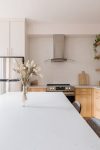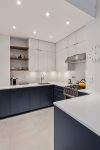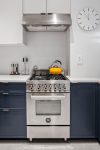
In a kitchen renovation project, the choice of range hood is definitely one of the last elements you think about. Yet, it's one of the kitchen's most essential appliances. Here are a few tips to make sure you pick the right range hood for your kitchen!
Among the plethora of models, materials and performance levels to consider, making the right choice can prove to be rather complex. Find out which elements you need to take into account before making your decision.
The range hood: Functions and design
On top of being indispensable for healthy home ventilation, the range hood also plays a decorative role. On the wall, above the island or integrated into the countertop, it blends into the space and adapts to all tastes and styles.
Two options are available to you: camouflage your range hood or leave it visible inside the room. In more minimal kitchens, it would be better to integrate it into a kitchen unit or a structure above the cooking surface, or have it built into the ceiling or countertop, in order for it to blend perfectly into the decor.
Beyond function and design


Apart from the look and functions the different range hood options can offer, it’s also crucial to pay attention to the noise level and performance of the models you’re considering.
Noise level
Ventilation devices are known to make a certain amount of noise, which can sometimes prove to be rather aggressive. It’s important to know that the stronger a range hood is, the louder it’s going to be. While current technological advancements allow for quieter and quieter range hoods, an efficient range hood will nonetheless generate a certain amount of noise.
At maximum speed, the sound made by your range hood should not exceed 67 decibels, which is the level of a somewhat animated conversation. In order to obtain a range hood with better performance and near-total silence, if possible the range hood’s motor could be installed in an isolated space: in the basement, an adjacent garage, or even the attic.
Power
The power of a range hood is usually calculated in cubic feet per minute (CFM). Make sure you choose a range hood boasting at least 250 CFM. You should know, however, that models with a power greater than 450 CFM are highly recommended.
Range hoods types
The traditional range hood


Traditional range hoods are installed against a wall or under a storage unit. They are usually available in a stainless steel finish, or in white or black, to match the rest of the appliances.
Keep in mind:
- Suction capacity is usually limited;
- It is perfect for small spaces;
- It is more affordable.
The chimney hood

The more decorative chimney hood has been among the most popular in the past few years. Against a wall or central, fastened to the ceiling, it comes in a vast array of shapes and colors. Circular, rectangular, trapezoidal, curved or cubic, it becomes an important part of the kitchen’s overall look. It is available in a stainless steel, aluminium or glass finish: there are quite a few choices on hand for this kind of range hood.
Keep in mind:
- It features a high level of performance;
- It looks better;
- It is available in different sizes, models and colors;
- It’s a model suited to gas stoves.
The tilt-out hood

The tilt-out hood is visible when required, and retracts as needed: you simply need to press on a touch-sensitive band or a remote control. It is therefore the perfect balance between the visible range hood and its hidden counterpart.
Keep in mind:
- It’s the best option for a cooking space located on an island;
- It is not suitable for gas stovetops;
- Its performance is more limited, compared with range hoods located on the wall or ceiling.
The built-in hood

Featuring either manual or automatic controls, the built-in hood is located in a cabinet or ornamental structure: it perfectly blends into the design. It is suitable for all types of stovetops, and comes with a variety of options and performance levels. Though it is a device that doesn’t really look like much on its own, it allows other architectural elements of the design to take center stage.
Keep in mind:
- It must absolutely be built into a structure;
- It is suitable for all types of cooking appliances;
- It is available in many different sizes;
- Several performance levels are available.
The microwave hood

The microwave with a built-in hood is installed on a wall, above the cooking surface, rather than on the counter. It’s a great option when the available space in the kitchen is an issue. It thus combines the microwave function with the ventilation function of a range hood within a single appliance.
Keep in mind:
- The ventilation function doesn’t perform as well;
- The appliance combines two different functions;
- It’s a great option for small kitchens.
The type of cooking appliance you use will influence your choice of range hood, but also take into account your cooking habits. You love grilling meat inside? Consider purchasing a more powerful ventilation device.
Finally, on top of extracting bad smells and lighting your cooking top, your range hood needs to match your decor and meet your needs. Seek help from an appliance consultant to choose the right new range hood for your kitchen. Your kitchen designer can also direct you towards an option that will perfectly match your design.